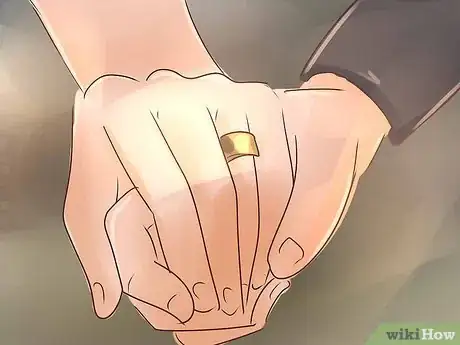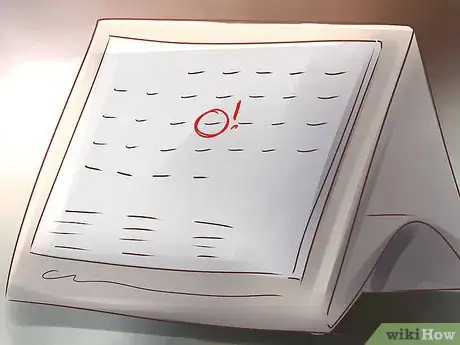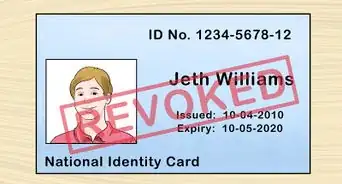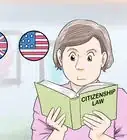This article was co-authored by Timothy Morson. Timothy Morson is a Canadian Immigration Specialist and a former Canadian Diplomat. With over 30 years of experience, Timothy specializes in Canadian immigration programs, immigration management, employer compliance, and international mobility. He holds a BA in Political Science from Concordia University and an MA in Journalism from Western University. Timothy is accredited by the Immigration Consultants of Canada Regulatory Council (ICCRC), Immigration Quebec, and is a member of the Order of Chartered Administrators of Quebec (Adm.A). He works to help people and companies around the world achieve their immigration goals.
There are 7 references cited in this article, which can be found at the bottom of the page.
wikiHow marks an article as reader-approved once it receives enough positive feedback. This article has 17 testimonials from our readers, earning it our reader-approved status.
This article has been viewed 816,153 times.
The U.S. Department of State or Bureau of Consular Affairs and Citizenship and Immigration Canada allows for citizens to have dual citizenship, meaning it is not required for you to give up citizenship if you plan to obtain a second foreign nationality. However, the methods you are able to obtain dual citizenship vary between Canada and the United States of America. When you have successfully acquired dual citizenship, you pledge allegiance to both countries and are required and expected to follow the laws of both countries. Having dual citizenship can be quite beneficial if you travel between the two countries a lot or have a permanent resident in one or both countries, allowing you to vote in elections and receive benefits from both countries.
Steps
Knowing the Basics of Dual Citizenship in USA and Canada
-
1Prove that you are a permanent resident to obtain citizenship. In both Canada or the US, in order to be eligible for citizenship, you will need to have been a permanent resident of both countries for several years. This means if you were not born in either country, don't have parents born in either country, and you have never lived in either the Canada or the US, it may take you several years and even up to a decade before you can apply for citizenship.
- Since Canada and the US are neighbors and have benefited from each other in various ways, it has lead many people to believe dual citizenship is easy to obtain. However, this is not the case.
-
2Obtain a green card in the US. If you are not citizen of the US and you were not born in the US or have parents born in the US, you will need to apply for a green card in order to qualify as a permanent resident of the US. Permanent residency is crucial to be eligible to apply for US citizenship. Green cards allow non-US citizens to live in the US on a permanent basis. You can qualify for a green card in three ways:
- Having close family members who are US citizens or permanent residents.
- Being offered a job in the US where your employer is not able to find a worker in the US.
- Investing more than $1 million USD in a US business.[1]
Advertisement -
3Get permanent residency status in Canada. If you are not a citizen of Canada or were born in Canada, you will need to apply for permanent residency before you can be eligible for a Canadian citizenship. If you are already a permanent resident, you must meet several conditions before you are eligible for Canadian citizenship:
- You need to have been physically present in Canada for at least 1095 days (3 years) in the 5 year period before you apply for Canadian citizenship. You must also be sure to have filed your personal income tax declaration for at least 3 years in that same period.[2]
- You must not be under review for immigration or fraud reasons or be under a removal order.
-
4File taxes if you are a US citizen. This is mandatory. Whether you live in the US or not, you will have to file taxes each year if you are a US citizen. You are taxed based on your worldwide income regardless of where you live.[3] For example, if you have been living in Canada for the past year, you will need to file both Canadian and U.S. tax returns.
- Fortunately, the US and Canada have a tax treaty that provides relief for individuals with dual citizenship so they don't have to pay double tax. Instead, they pay one country and receive credit in the other for taxes paid.
- If you are a Canadian citizen, you only have to file taxes for the period you have been actually living in Canada. So if you have been living in the US for a year, you only have to file a US tax return.
-
5Be careful when travelling with two passports. In most cases, if you are a citizen of two countries, you will have obtained a passport for both. When you are entering certain countries, you risk having one of your passports confiscated for whatever reason. You may also need to show both passports if you have dual citizenship during immigration.
- Always research the policies of travelling as a dual citizen of wherever your destination is.
Obtaining a US Citizenship
-
1Determine if you are eligible for citizenship. There are three main ways that make you eligible to apply for a US citizenship if you are a Canadian citizen. All details and official requirements can be found on the United States Citizenship and Immigration Services (USCIS) website. However, if you have given up or relinquished your US citizenship in the past, you will not be able to obtain a US citizenship. The only exception is if you renounced your US citizenship under the age of 18. Then you must make the desire to be a US citizen known to the Department of State within six months of turning 18.[4] Other than that, you can become a US citizen if:
- You have been a permanent resident for at least 5 years (citizenship through naturalization).
- You were born in Canada, but your genetic parents or non-genetic gestational mother were legal US citizens at the time of your birth (citizenship through parents).
- Your married spouse is a legal US citizen and you have been a permanent residence and married to the same spouse for at least 3 years (naturalization for spouses of U.S. citizens).
-
2See if you meet the qualifications to become a US citizen by naturalization. There are several requirements you need to meet before you can be eligible to apply for a US citizenship through naturalization:
- You must be 18 years or older to apply.
- You must be a green card holder for at least 5 years.
- You must file your application with the State or Service District with jurisdiction that you have truly reside in your place of residence and have been for at least 3 months before applying for citizenship.[5]
- You must have been continuously living in the US for 5 years after obtaining a green card and after applying for citizenship. That means you have not been outside of the US for more than 6 months and can prove that you have been physically present in the US 30 months before you plan to apply for citizenship.[6]
- You must be able to read, write, and speak English and have knowledge and understanding of US history and government.
- You must be a person with good moral character, accept the principles of the Constitution of the United States, and agree with the good order and happiness of the United States during all relevant periods under the law.
-
3Ensure you qualify for citizenship by naturalization if you are a spouse of a US citizen. In most cases, you are required to have had permanent residence in the US for at least 3 years and married to your spouse at the same time. However, if your spouse is employed abroad for at least 1 year by the US government, military, or other qualifying employer, no minimum time of permanent residence is specified or required of you. But you still need to have a green card or be a permanent resident of the US. The requirements for citizenship are quite similar to the requirements needed for applicants who are applying for citizenship through naturalization:
- You must be 18 years or older to apply.
- You must be a green card holder for at least 3 years.
- You must be in a civil union with your US citizen spouse during the 3 years before you submit your citizenship application and all the way up to your citizenship examination date.
- You must file your application with the State or Service District with jurisdiction that you have truly reside in your place of residence and have been for at least 3 months before applying for citizenship.[7]
- You must have been continuously living in the US for 3 years after obtaining a green card and after applying for citizenship. That means you have not been outside of the US for more than 6 months.[8]
- You must prove you have been physically present in the US for at least 18 months out of the 3 years before your citizenship application date.
- You must be able to read, write, and speak English and have knowledge and understanding of US history and government.
- You must be a person with good moral character, accept the principles of the Constitution of the United States, and agree with the good order and happiness of the United States during all relevant periods under the law.
- If your spouse is being employed abroad, you must establish that you plan to depart immediately after you receive citizenship and also reside in the US immediately after your spouse's employment is terminated.
-
4Check to see if your child is eligible for US citizenship. If you plan to have your child in Canada and you and/or your spouse is a US citizen, your child will most likely be able to receive US citizenship automatically through you. In most cases, permanent residency is not required of the child but in certain circumstances, you must be able to prove you have resided the US for a certain period of time. Check the USCIS Policy Manual guidance on Children of U.S. Citizens for a full list of requirements.
- The rules for citizenship through parents is extremely complex. It is dependent on various things such as whether the child was born in or out of wedlock, when the child was born, when the parent was born, and if one or both parents were US citizens at the time of birth. In some circumstances, blood tests would need to be done to prove a parent is indeed blood related to the child.
- If parents are naturalized US citizens after the birth of a child, the child must have been under 18 at the time their parents were naturalized and must have had a green card before 18.
- If you were adopted or your child is an adopted Canadian child, the adoptive parent must have adopted them before the child's 16th birthday and have had legal custody at the same time. As well, the child must have been admitted to the United States as an orphan or Convention adoptee.
-
5Fill out the correct US citizenship application. Depending on how you plan to obtain a US citizenship, you will be required to fill out a different form. All forms are located on Official Website of the United States Citizenship and Immigration Services (USCIS). You can find PDF files of detailed instructions on how to fill out these forms, what the application fee is, and even a comprehensive checklist of all required documents.
- If you are applying through naturalization, fill out Form N-400. You will be instructed to mail in your application along with a $750 check payable to the US Department of Homeland Security. Where you mail in your application depends on where you live and whether you are a current or former member of the military, spouse of a current or former member of the military, or close relative to a deceased member of the military. Your application requires you to not only submit Form N-400, but also any copy proofs of marriage certificates, birth certificates, Armed Forces memberships, and even photographs for evidence.
- If you are applying for citizenship through your parents, fill out Form N-600. You will be instructed to mail in your application to the USCIS Phoenix Lockbox facility along with a $600 check payable to the US Department of Homeland Security. The price is adjusted to $550 if the child is adopted and completely waived if the applicant is a child of a veteran or member of the US Armed Forces. Your application requires you to not only submit Form N-600, but also any copy proofs of parent or parents' citizenship, birth certificates, Armed Forces memberships, and even photographs for evidence.
-
6Wait for the USCIS to respond. Within a month or two, the USCIS will send you a receipt to let you know your application has been received and is in processing. On the receipt, there will be a number you can use to check up on the status of your application through their website.
- In most cases, the USCIS will also send you a letter a few months later telling you come to a fingerprinting appointment. A date and time will be scheduled for you to go into your local USCIS office. You will be required to bring in your letter, green card or resident card, and an additional form of identification with your photograph on it (driver's license, or passport).
- You may be required to send the USCIS additional documents.
-
7Wait for your naturalization exam to be scheduled. If you are applying through naturalization, you will be interviewed and required to take a naturalization exam where your knowledge of US history and government will be tested. The USCIS will send you a letter with a scheduled location, date, and time of your examination and interview. If you need to reschedule, you must ask in writing to have your interview rescheduled.
- If you don't receive a letter within 7 months after you have applied, contact the USCIS customer service at 1-800-375-5283.
- There are many resources available to help you study for your naturalization test. USCIS provides some study materials on their website. You can also find tutors or classes that specialize in helping people take the naturalization exam.
-
8Go to your naturalization interview and examination. You only have 2 chances to pass the examination. If you fail both times, you will need to restart your application process again. If you don't show up to your interview and you don't contact the USCIS beforehand, the USCIS will close your case and application. You will have one year to reopen your case before your application is denied and you will need to restart your application process all over again. If you do show up for your interview, the process consists of:
- An USCIS officer will ask about your application and your background. It's important you go over what you wrote in your application and be as truthful as possible during the interview. This portion of the process counts towards the speaking component of the naturalization exam.
- To test your reading abilities, you will be asked to read aloud three English sentence. The USCIS provides a helpful Reading Vocabulary to prepare for your exam.
- To test your writing abilities, you will be asked to write out three English sentences provided by the USCIS officer. The USCIS provides a helpful Writing Test Vocabulary to prepare for your examination.
- Finally, during your interview, you will be asked 10 civics questions and you must answer 6 of them correctly to pass this portion of the exam. Thankfully, the USCIS provides you with a list of 100 possible civics questions with their answers that will be asked.
- You will receive your naturalization exam results after the interview and be told whether you are approved or denied citizenship.
-
9Take your oath of allegiance. Once you are approved for US citizenship, you will take part in a naturalization ceremony where you will say the Oath of Allegiance and officially become a citizen of the US. In some cases, you can take the oath on the same day as your interview. In most cases, the USCIS will mail you a letter with the date and time of your ceremony.
- You will be asked to fill out Form N-445 before your ceremony which confirms your ceremony details and lists the required documents you must bring to your ceremony. It also asks you a few brief questions about yourself in case your status has changed after your examination (for example, you married, divorced, or was widowed any time between your naturalization examination and ceremony).
- When you arrive for your ceremony, a USCIS officer will review with you your responses in your N-445 form.
- You will be required to turn in your Permanent Resident Card or Green Card at the ceremony.
- After you take your Oath of Allegiance, you will be given a Certificate of Naturalization. Be sure to review your certificate to ensure it is free of errors. Your certificate acts as proof of your US citizenship.
- After your ceremony, you are now eligible to apply for a US passport, register to vote, and asked to update your social security records at your local Social Security Administration (SSA) office.
Obtaining a Canadian Citizenship
-
1Find out if you are already a Canadian citizen. In some cases, you may have already been automatically given Canadian status. The Government of Canada allows you to submit an application for proof of Canadian citizenship to help you determine if you are a Canadian citizen (this is different from applying for a Canadian citizenship). If you are indeed a Canadian citizen, you will be given your Certificate of Citizenship. In most cases, you are a Canadian citizen already if:
- You were born in Canada.
- Your parent or legal guardian naturalized you as a minor by applying for your citizenship.
- You were born outside of Canada after April 17, 2009 and at least one of your parents were born in Canada, or naturalized before your birth.
- The changes made in 2015 and 2009 of the Citizenship Act apply to you. A comprehensive list of changes can be found on the Citizenship and Immigration Canada website.
-
2Determine your eligibility for citizenship. Before applying for Canadian citizenship, you should check if you are eligible to receive citizenship. To be eligible for Canadian citizenship, you must meet these conditions:
- Age: You must be at least 18 years old to apply. If you are applying for a child under 18, you must be the child’s parent, adoptive parent or legal guardian, the child must be a permanent resident, and one parent must be a Canadian citizen or be applying to become a citizen at the same time.
- Permanent Resident Status: You must have permanent resident status and must not have any unfulfilled conditions related to your status.[9] That means you are not under investigation, have not committed any crimes, or under a removal order. Fortunately, you don't need a PR card to apply for citizenship.
- Time lived in Canada: After you have obtained permanent residency, you will have needed to be physically present in Canada for at least 1095 days (3 years) in the 5-year period before you apply for Canadian citizenship.[10] These conditions do not apply to children under 18 or certain Crown servants. Luckily, the government has provided a tool to help you find out if you have lived in Canada long enough.
- Income tax filing: You must have met your personal income tax filing obligations for at least 3 of the last 5 years immediately before the date you apply for citizenship.
- Intent to reside: You must declare your intent to reside during the citizenship application process. That means you intend to live in Canada, work outside Canada as a Crown servant, or live abroad with certain family members who are Crown servants.
- Be able to speak English or French: You will need to send documents to prove that you can speak and listen in English or French. An officer during your application process will also evaluate your language skills. Being able to speak in English or French means you can take part in short, everyday conversations about common topics, understand simple instructions, questions and directions, use basic grammar, and know enough common words and phrases to answer questions and express yourself.
- Know Canada well: You will need to take a citizenship test that tests your knowledge of Canada.[11] You will need to know Canada's history, values, institutions, and symbols. It is usually a written test but can sometimes be taken orally with an officer.
- Prohibitions: If you have committed a crime, you are not eligible for citizenship for a period of time. That means you are not currently on parole or probation, you have not been convicted or indicted of any crimes, and you are not on trial or involved in an appeal of an offence.
-
3Get an application package. On Canada's Immigration website, you can find information guides about how to fill out applications, how to pay fees, and how to submit applications. There are three kinds of application packages:
- For Adults (over 18 years old).
- For Minors (under 18 years old).
- For Canadian Armed Forces (over 18 years old).
- Make photocopies of all documents. The detailed instruction guide will tell you what original documents you will need to bring to you test or interview.
- When you submit your application, you must include all the forms, information, documents and fees, including postal codes for all Canadian and overseas addresses.
-
4Prepare for your citizenship test. You will have to take a citizenship test if you are between the ages of 14 and 64 when you apply for citizenship.[12] If a minor is taking the citizenship test or going for an interview, a parent or guardian may accompany them, but they cannot help the child during the test or interview. Prepare for the citizenship test by:
- Reading Discover Canada. You download a PDF or eBook copy as well as listen to an audio version of the book.
- Brushing up on Canada's beliefs on the rights, freedoms and responsibilities of Canadian citizens, Canada's democracy and ways to take part in Canadian society, Canadian political and military history, social and cultural history and symbols, and Canadian physical and political geography.
- Improving your English or French to prepare for the oral or interview portion of the test.
-
5Take the citizenship test. You will receive a notice about the time, date, and location of your test. If you cannot make it to the scheduled date, contact the Call Centre and they will reschedule your citizenship test. If you don't attend the test, you will also have to contact the Call Centre or they will close your application.
- Bring your original documents that you sent with your application to the test and any passports or travel documents you have had in the past four years.
- Depending on your application, Immigration Canada will decide whether you do an oral or written test. If you have trouble reading and writing in English or French, you will most likely be given an oral test.
- Your test results will be given to you right after your test. If you pass, a ceremony date to take your Oath of Citizenship will be given to you at the same time as your results. The ceremony will occur within six months after your test. If you do not pass, you will either be asked to reapply for citizenship or you will be rescheduled to take another test or interview with an officer.
-
6Attend your Oath of Citizenship ceremony. To receive your certificate of citizenship, all applicants over the age of 14 must attend the ceremony. You will need to bring:
- Your original immigration documents.
- Your permanent resident card, if you have one.
- Your Record of Landing if you became a permanent resident before June 28, 2002.
Warnings
- Citizens of Canada can get a Certificate of Canadian Citizenship but this certificate is not a travel document and cannot be used in place of a Canadian passport for travel abroad.⧼thumbs_response⧽
- Laws change constantly. Some countries require you to live in the country to participate in political elections or make physical appearances every few months to maintain citizenship.⧼thumbs_response⧽
- Possessing dual citizenship may complicate any legal matters for you if the countries' laws conflict with each other or assistance abroad is needed.⧼thumbs_response⧽
- As a dual citizen, you must obey the laws of both countries you have citizenship for.⧼thumbs_response⧽
References
- ↑ http://www.alllaw.com/articles/nolo/us-immigration/dual-citizenship-united-states-canada.html
- ↑ Timothy Morson. Canadian Immigration Specialist. Expert Interview. 26 January 2021.
- ↑ https://turbotax.intuit.ca/tax-resources/tax-compliance/does-having-dual-citizenship-impact-your-taxes.jsp
- ↑ https://travel.state.gov/content/travel/en/legal/travel-legal-considerations/us-citizenship/Renunciation-US-Nationality-Abroad.html
- ↑ http://www.uscis.gov/policymanual/HTML/PolicyManual-Volume12-PartD-Chapter6.html
- ↑ http://www.uscis.gov/us-citizenship/citizenship-through-naturalization/continuous-residence-and-physical-presence-requirements-naturalization
- ↑ http://www.uscis.gov/policymanual/HTML/PolicyManual-Volume12-PartD-Chapter6.html
- ↑ http://www.uscis.gov/us-citizenship/citizenship-through-naturalization/continuous-residence-and-physical-presence-requirements-naturalization
- ↑ Timothy Morson. Canadian Immigration Specialist. Expert Interview. 26 January 2021.
- ↑ Timothy Morson. Canadian Immigration Specialist. Expert Interview. 26 January 2021.
- ↑ Timothy Morson. Canadian Immigration Specialist. Expert Interview. 26 January 2021.
- ↑ http://www.cic.gc.ca/english/citizenship/cit-test.asp
About This Article
To have dual citizenship in the US and Canada, start by applying for a US green card if you’re Canadian, or Canadian permanent residency status if you’re American. Then, look up the requirements for being a US citizen on the US Citizenship and Immigration Services website. Next, check Canada's immigration website to see if you meet the qualifications for citizenship. Depending on your circumstances, you may be required to take a citizenship test for either country, which may include civics questions, a writing test, and a language exam. For more advice, like how to tell when you should travel with one or both passports, read on!



















































































